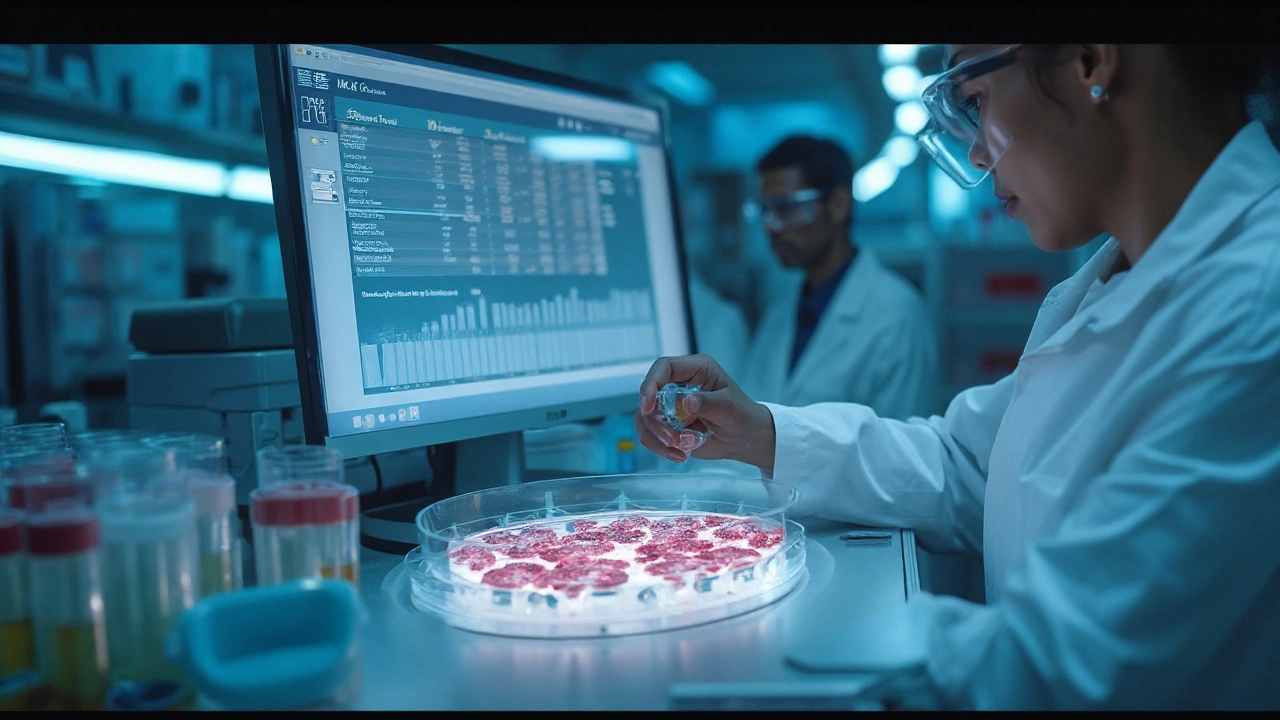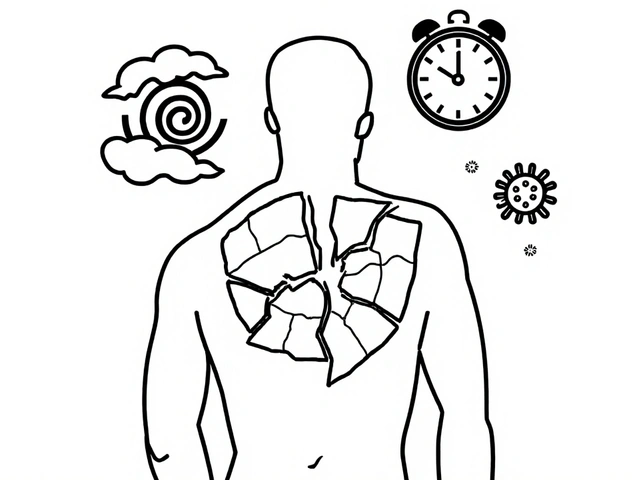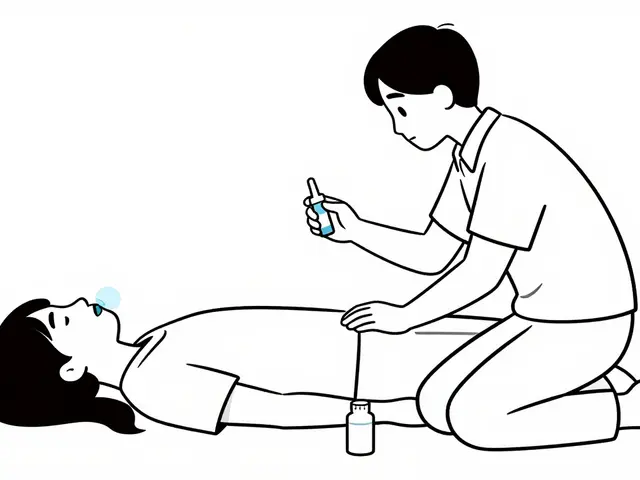Understanding the Different Types of Anemia - A Complete Guide

- Colin Hurd
- 25 September 2025
- 16 Comments
Anemia is a medical condition characterized by a reduced number of healthy red blood cells or insufficient hemoglobin to carry adequate oxygen to body tissues. It affects millions worldwide and shows up in many flavors, each with its own trigger and treatment plan.
Why Knowing the Specific Type Matters
When you hear "anemia," the first thought is often iron deficiency, but that’s just one slice of a broad pie. Different causes demand different labs, therapies, and follow‑up. Mis‑labeling a patient can lead to unnecessary supplements, delayed therapy, or even dangerous complications.
Major Categories of Anemia
Clinicians usually group anemia into three umbrella categories: production problems, loss or destruction, and chronic disease interference. Below are the most common concrete types you’ll encounter.
Iron‑deficiency anemia is a microcytic, hypochromic anemia caused by inadequate iron stores, most often from poor dietary intake, chronic blood loss or malabsorption. It accounts for roughly 50% of all anemia cases globally.
Vitamin B12 deficiency anemia is a macrocytic, megaloblastic anemia resulting from insufficient cobalamin, usually due to pernicious anemia, malabsorption (e.g., Crohn’s) or strict vegan diets. Neurological signs often accompany the hematologic picture.
Folate deficiency anemia is a macrocytic anemia caused by low folic acid intake or impaired absorption, common in pregnancy, alcoholism and certain anticonvulsants. Unlike B12 deficiency, it rarely produces neurologic deficits.
Hemolytic anemia is a normocytic anemia that arises when red cells are destroyed faster than the marrow can replace them, either from intrinsic defects (e.g., hereditary spherocytosis) or extrinsic factors (autoimmune, infections, drugs).
Aplastic anemia is a pancytopenia due to bone‑marrow failure, often idiopathic but linked to chemicals, viral infections or autoimmune attack. It requires urgent specialist care.
Sickle cell disease is a hereditary hemoglobinopathy where a single β‑globin gene mutation (HbS) causes red cells to sickle, leading to vaso‑occlusive crises and chronic hemolysis. It exemplifies a genetic form of anemia with systemic complications.
Lab Fingerprints - How Doctors Differentiate Types
Every anemia leaves a trail in the blood work. Below is a quick cheat sheet of the most useful indices.
- Mean corpuscular volume (MCV): low in iron deficiency, high in B12/folate deficiency, normal in hemolysis and chronic disease.
- Serum ferritin: low in iron deficiency, normal/high in anemia of chronic disease.
- Serum vitamin B12 & folate: low levels pinpoint the respective megaloblastic anemia.
- Reticulocyte count: high in hemolysis (bone‑marrow response), low in production problems.
- Peripheral blood smear: sees iron‑deficiency microcytes, B12 macro‑ovalocytes, sickle cells, spherocytes, etc.
Comparison Table - Quick Reference
| Type | Primary Cause | Lab Hallmark | Typical Symptoms | First‑Line Treatment |
|---|---|---|---|---|
| Iron‑deficiency | Insufficient iron intake or chronic loss | Low ferritin, low MCV | Fatigue, pica, spoon‑shaped nails | Oral iron supplementation + address source of loss |
| Vitamin B12 deficiency | Malabsorption or dietary lack | Low B12, high MCV, hypersegmented neutrophils | Fatigue, paresthesia, gait disturbance | IM cyanocobalamin or high‑dose oral B12 |
| Folate deficiency | Poor diet, alcoholism, pregnancy | Low folate, high MCV | Fatigue, glossitis | Folic acid 1mg daily |
| Hemolytic | Premature RBC destruction | Elevated LDH, low haptoglobin, high retics | Jaundice, dark urine, splenomegaly | Treat underlying cause; steroids for AIHA, splenectomy in hereditary forms |
| Aplastic | Bone‑marrow failure | Low retics, pancytopenia | Bleeding, infections, fatigue | Immunosuppressive therapy or stem‑cell transplant |
| Sickle cell disease | β‑globin gene mutation (HbS) | Hemoglobin S on electrophoresis, sickled cells | Pain crises, chronic anemia, organ damage | Hydroxyurea, blood transfusion, gene therapy (emerging) |
Related Concepts and How They Fit Together
Understanding anemia doesn’t happen in isolation. Below are a handful of linked ideas that frequently pop up in diagnosis and management.
- Erythropoietin (EPO): Hormone produced by the kidneys that drives red‑cell production. Recombinant EPO is used in chronic kidney disease‑related anemia.
- Blood transfusion: Provides immediate hemoglobin boost but carries risks; reserved for severe symptomatic anemia or acute blood loss.
- Bone‑marrow biopsy: Confirms aplastic anemia or infiltrative marrow disease when peripheral labs are inconclusive.
- Iron studies panel: Ferritin, transferrin saturation, and serum iron together give the most accurate picture of iron status.
- Nutrition counseling: Dietitians help craft iron‑rich or B12‑rich meal plans, crucial for long‑term maintenance.

Practical Tips for Patients and Caregivers
- Know your numbers: Keep a copy of recent CBC, ferritin, B12, and retic count. Trends matter more than a single value.
- Ask about hidden blood loss: Heavy menstrual periods, gastrointestinal bleeding (ulcers, colorectal cancer) are common culprits.
- Mind your meds: Proton‑pump inhibitors can impair B12 absorption; antacids may affect iron uptake.
- Watch for red‑flag symptoms: Sudden shortness of breath, chest pain, or neurological tingling require urgent review.
- Follow up on treatment response: Iron supplements need 2-3months to replenish stores; B12 injections are typically given monthly initially.
When to Seek Specialist Care
If initial labs point to a rare inherited form (e.g., sickle cell, thalassemia), severe aplastic anemia, or refractory hemolysis, a referral to a hematologist is essential. Early intervention can prevent organ damage and improve quality of life.
Future Directions - What’s Coming in Anemia Care?
Research is pushing beyond simple supplementation. Gene‑editing techniques (CRISPR‑Cas9) are in early trials for sickle cell disease and β‑thalassemia. Oral hepcidin antagonists aim to treat anemia of chronic disease by unlocking iron stores. Meanwhile, point‑of‑care hemoglobin monitors are becoming more accurate, allowing quicker triage in remote clinics.
Key Takeaways
- Anemia is a symptom, not a disease; the underlying cause dictates therapy.
- Lab patterns-MCV, ferritin, B12, reticulocyte count-are the quickest way to differentiate anemia types.
- Nutrition, medication review, and chronic‑disease management are often as important as iron pills or injections.
- Specialist input is crucial when the picture is atypical, severe, or genetically driven.
Frequently Asked Questions
Can iron‑deficiency anemia be cured without supplements?
If the iron loss source is stopped (e.g., treating a bleeding ulcer or reducing menstrual blood loss) and the diet supplies enough iron, the body can rebuild stores naturally. However, most clinicians still prescribe a short course of oral iron to speed recovery and ensure complete repletion.
Why do some people with B12 deficiency develop nerve problems?
Vitamin B12 is essential for myelin synthesis, the protective sheath around nerves. Prolonged deficiency leads to demyelination, causing tingling, balance issues, and even memory loss. That’s why neurologic assessment accompanies laboratory confirmation.
Is it safe to take iron supplements if my ferritin is normal?
No. Normal or high ferritin indicates adequate iron stores. Unnecessary iron can cause gastrointestinal upset, constipation, and in rare cases, iron overload, which damages the liver and heart. Always verify low ferritin before supplementing.
What distinguishes hemolytic anemia from anemia of chronic disease?
Hemolytic anemia shows a high reticulocyte count as the marrow tries to replace destroyed cells, plus elevated lactate dehydrogenase (LDH) and low haptoglobin. Anemia of chronic disease, conversely, presents with normal or low retics, high ferritin (iron trapped in macrophages), and low serum iron.
Can diet alone manage sickle cell disease?
Diet helps maintain overall health but cannot stop sickling events. Hydroxyurea remains the cornerstone therapy, and emerging gene therapies aim to correct the underlying mutation. Adequate hydration and folate intake are supportive measures.




Comments
Sadie Bell
Great overview, super helpful!
September 25, 2025 AT 16:36
Noah Bentley
Sure, because everyone loves a 15‑sentence lecture on iron, right?
But hey, at least the spelling is spot‑on this time.
September 30, 2025 AT 03:16
Kathryn Jabek
It is indeed commendable that the author has taken the time to delineate the myriad etiologies of anemia with such scrupulous attention to detail, thereby furnishing both laypersons and clinicians with a robust scaffold upon which to erect further understanding.
One cannot overstate the import of distinguishing iron deficiency from megaloblastic processes, for the therapeutic trajectories diverge dramatically.
The emphasis on mean corpuscular volume (MCV) as a diagnostic beacon is both pragmatic and pedagogically sound.
Moreover, the elucidation of serum ferritin thresholds elegantly underscores the nuance required when interpreting iron studies in the context of inflammatory states.
Equally vital is the discussion surrounding vitamin B12 and folate, wherein the author deftly navigates the overlapping yet distinct clinical manifestations, such as peripheral neuropathy versus mere glossitis.
Hemolytic anemia, a realm fraught with heterogeneity, is rendered accessible through the inclusion of reticulocyte indices and lactate dehydrogenase metrics.
The segment on aplastic anemia judiciously alerts the reader to the urgency of specialist referral, a point often underappreciated in primary‑care curricula.
Sickle cell disease, portrayed not merely as a hematologic curiosity but as a systemic disorder, benefits from the author's integration of genetic underpinnings and emerging gene‑editing therapies.
The tabular comparison, succinct yet exhaustive, serves as an invaluable quick‑reference tool for clinicians juggling differential diagnoses.
In the practical tips section, the admonition to "know your numbers" resonates profoundly, reminding patients of the longitudinal nature of hematologic monitoring.
Finally, the contemplation of future directions, from oral hepcidin antagonists to point‑of‑care hemoglobin monitors, positions this guide at the vanguard of translational medicine.
Overall, the synthesis of pathophysiology, laboratory diagnostics, and therapeutic strategies is nothing short of exemplary.
It is a testament to the author's dedication to bridging the chasm between academic rigor and bedside applicability.
Such a comprehensive compendium undoubtedly empowers both patients and providers to navigate the complex landscape of anemia with confidence.
October 4, 2025 AT 13:56
Ogah John
Wow, that was a marathon read-impressive stamina!
But seriously, the way you broke down the lab fingerprints makes it way less intimidating for the rest of us.
October 9, 2025 AT 00:36
Kelvin Murigi
Happy to chime in with a quick clinical pearl: when you see a low retic count alongside pancytopenia, think bone‑marrow biopsy ASAP.
It can differentiate aplastic anemia from infiltrative processes early, saving precious time.
October 13, 2025 AT 11:16
ahmad matt
Honestly this guide feels like a laundry list of facts no one reads the whole thing just skim the headlines and miss the nuance.
October 17, 2025 AT 21:56
kristine ayroso
i get wha u r tryn to say but u cant just dump all that info it makes it hard 2 follow..maybe use less medical jargons?
October 22, 2025 AT 08:36
Ben Small
Love the energy behind this post! It’s exactly the kind of boost we need when tackling complex topics like anemia.
October 26, 2025 AT 18:16
Dylan Hilton
Just a gentle heads‑up: the phrase "iron‑deficiency microcytes" could be tightened to "microcytic iron deficiency" for smoother reading.
October 31, 2025 AT 04:56
Christian Andrabado
Reading this feels like a wave of melancholy, the endless lab numbers just echoing my own emptiness.
November 4, 2025 AT 15:36
Chidi Anslem
While the clinical details are thorough, it might help readers to see a short summary at the start, especially for those unfamiliar with hematology.
November 9, 2025 AT 02:16
Holly Hayes
People should stop romanticizing iron pills; they cause constipation and can be toxic.
November 13, 2025 AT 12:56
Penn Shade
Actually, the claim that iron supplements are often unnecessary is misleading; many patients truly need them to restore stores efficiently.
November 17, 2025 AT 23:36
Jennifer Banash
Bravo! This comprehensive guide is nothing short of a masterpiece, weaving together pathophysiology and patient care with exquisite clarity.
November 22, 2025 AT 10:16
Stephen Gachie
The profundity of this work lies not merely in its factual density but in its ability to elevate the humble hemoglobin to a symbol of human resilience and scientific triumph.
November 26, 2025 AT 20:56
Sara Spitzer
Sure, it’s thorough, but honestly it reads like a textbook. Could’ve been shorter.
December 1, 2025 AT 07:36